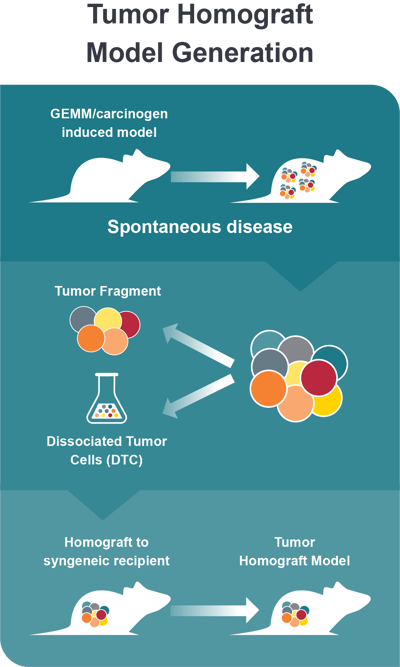Immunocompetent Murine Tumor Models: Spontaneous Tumor, Dissociated Tumor Cells and Murine Tumor Fragments
 Novel murine immunocompetent models are needed to overcome issues with commonly used syngeneic tumor models and genetically engineered animal models. Today, we review tumor homograft models and the alternative ways they can be created.
Novel murine immunocompetent models are needed to overcome issues with commonly used syngeneic tumor models and genetically engineered animal models. Today, we review tumor homograft models and the alternative ways they can be created.
Immunocompetent Preclinical Model
Immunocompetent mouse models served as a mainstay in preclinical cancer research for many decades. Today, syngeneic and genetically engineered mouse models (GEMM) are the workhorse in preclinical immuno-oncology studies. They’re widely used to test cross-reactive or surrogate immuno-oncology agents to understand mechanisms of action and predict response before moving to more complex humanized studies.
Syngeneic Models
Syngeneic mouse tumor cell lines are the most widely used model by far in preclinical immuno-oncology pharmacology studies. Syngeneic models are allografts immortalized from mouse cancer cell lines, developed from either spontaneously arising tumors in older mice or from carcinogen induction.
Advantages of Syngeneic Models
The models are engrafted back into the same inbred immunocompetent mouse strain. The identical host and cell line strain means that tumor rejection doesn’t occur, creating an immunocompetent model for immunotherapy assessment.
Limits of Syngeneic Models
There are a limited number of syngeneic cell lines available. This means that certain types of cancers are underrepresented, such as lung cancer, and that not all cancer types or subtypes are available.
In addition, as syngeneics are derived from immortalized cancer cell lines that have been passaged in vitro, you might see genetic drift from original disease. Specific or rare mutations and fusions seen in human disease are often not represented in these models.
As a result of their non-synonymous mutations, syngeneic models also often have a neo-antigen load significantly higher than found in most human cancers.
Genetically Engineered Mouse Models
In GEMM, one or several genes putatively involved in malignant transformation are deleted, mutated, or overexpressed. This results in spontaneous tumor development.
GEMM provide a more physiologically relevant tumor microenvironment by recapitulating some of the oncogenesis steps and localizing tumor growth to a specific and appropriate site. Most importantly, they grow in a fully immuno-competent environment, and are therefore appropriate for immuno-oncology research.
Advantages of GEMM
There is a large collection of GEMM available covering many common cancer indications, such as lung, prostate, breast, colon, and pancreatic cancers. This provides more subtype availability than for limited syngeneic cell lines.
GEMM has many other advantages over syngeneic cell lines, including a wide variety of well-characterized models featuring tumors with a clear molecular pathogenesis of disease within an immunocompetent setting.
GEMM also demonstrate a lower mutational burden than syngeneic lines, making them genetically more like human tumors. This is due to the use of strong oncogenic driver(s) and tumor suppressor loss to enable carcinogenesis.
Limits of GEMM
However, GEMM do have significant drawbacks for in vivo pharmacology studies. They have long latency periods, mice develop disease at different stages, and 100% penetrance is not achievable. Therefore, trying to use GEMM for efficacy testing results in very long and challenging studies and a “rolling enrollment” approach.
Somatically Engineered Mouse Models (SEMM)
Similar to GEMM models, spontaneous tumor development in SEMM is induced by artificial alteration of oncogene via various genetic engineering strategies.
Advantages of SEMM
SEMM is a valuable preclinical model since it recapitulates physiologically relevant tumor microenvironment, including precancerous lesions in immuno-competent mice, which is comparable with GEMM.
Moreover, somatically engineering, which can be achieved by delivery of the genetic engineering tool directly in adult animals, without complicated and time-consuming embryo engineering and animal breeding, provides a more flexible timeline compared with GEMM.
Limits of SEMM
Nevertheless, the limitation of SEMM is also apparent. For example, genetic engineering enzymes or delivery vectors usually are immunogenic. There are also more factors that can affect the tumor incidence in SEMM than GEMM.
On the other hand, efficiency of genetic operation in somatic cells in vivo, especially the generation of large fragment knock-in and point mutation is much lower than in germline cells ex vivo. Therefore, the realizable genetic operation in SEMM is much more limited than GEMM. However, SEMM is a better choice for modeling diseases caused by embryonic lethal chromosomal rearrangements, which is difficult to operate in GEMM but can be easily achieved in SEMM.
Murine Tumor Homograft Models
To work around these problems, allograft fragments or dissociated tumor cells (DTC) of GEMM spontaneous tumors can be used to create tumor homograft models. The fragments/DTC are implanted into a cohort of mice of the same background strain, creating a system combining the strengths of GEMM with improved operational simplicity, consistency, and growth.
Generating tumor homograft models by either fragments or DTC each have distinct advantages and limitations.
Generation of Murine Tumor Homograft by Tumor Fragments
Advantages of Tumor Homograft by Fragments
Tumor fragments better reproduce the histological nature of the primary tumor, with original 3D architecture and cell-to-cell contact. These factors are known to influence signaling, and therefore potentially the efficacy of the treatment.
Additionally, in an orthotopic setting, implantation of intact tumor fragments increases metastasis efficiency compared to cell suspensions, while avoiding the artificial diffusion of injections of cell suspensions.
Limitations of Tumor Homograft by Tumor Fragments
However, implantation of tumor fragments with unknown cell number and regional heterogeneity within the tumor leads to higher inter- and intra-study variability. Also, generating multiple small similar-sized fragments limits the number of secondary recipients.
Generation of Murine Tumor Homograft by DTC
Advantages of Tumor Homograft by DTC
On the other hand, by implanting DTC, tumor heterogeneity is equally distributed, and engraftment and tumor growth are more efficient than for tumor fragments. Components of the tumor microenvironment are also homogeneously represented, including epithelial cells, fibroblasts, and tumor infiltrating lymphocytes.
DTC banks can be established with high percentages of viable cells both pre-freeze and post-thaw. DTC from an individual mouse tumor also provides sufficient viable cells that exceed the capacity of fragments obtained from an individual tumor.
Pooling cells from several tumors, or expanding individual tumors in secondary recipients, can generate a virtually unlimited, on-demand source of tumor cells for preclinical studies.
Limitations of Tumor Homograft by DTC
- Tumor homograft by DTC does have the limitation of difficult to reserve tumor histological structure.
Advantages and Limitations by Model Type
| Model Type | Advantages | Limitations |
|---|---|---|
| Syngeneic |
|
|
| GEMM |
|
|
| SEMM |
|
|
| Murine Tumor Homograft - Fragments |
|
|
| Murine Tumor Homograft - DTC |
|
|
Comparative Strengths and Weaknesses by Model Type (+ = strength, x = weakness)
| Syngeneic | GEMM | SEMM | Murine Tumor Homograft Fragments |
Murine Tumor Homograft DTC |
|
|---|---|---|---|---|---|
| In vivo efficacy | +++ | ++ | ++ | +++ | +++ |
| Large scale pharmacology studies |
+++ | + | + | +++ | +++ |
| Tumor rejection | x | x | x | x | x |
| Extensive indications and target |
+ | ++ | + | ++ | ++ |
| Physiologically relevant tumor microenvironment |
x | +++ | +++ | +++ | ++ |
| Grown in fully immuno-competent environment |
+++ | +++ | +++ | +++ | +++ |
Summary
Syngeneics and murine tumor homografts both provide excellent model systems for testing the in vivo efficacy of immunotherapeutics. Syngeneics provide a robust, reproducible platform for performing large scale pharmacology studies. Murine tumor homografts share the advantages of GEMM/SEMM but can be used in a manner similar to syngeneics.
Cohorts of Murine tumor homograft models can be engrafted in a highly reproducible and robust manner to allow larger scale evaluation of test immunotherapeutics.

